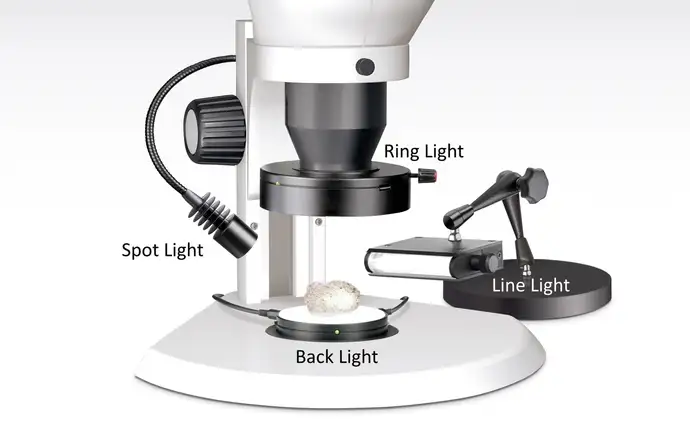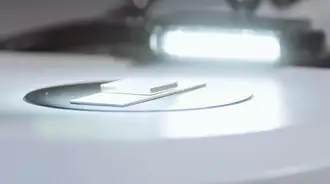
Illumination for stereo microscopy
The importance of good lighting
Samples in microscopy can be diverse – from the investigation of circuit boards or flower seeds, where homogeneous illumination may be vital to stitch images together, to corrosion samples where it’s often necessary to define the surface topography by shadow effects.
To make all relevant details visible, the correct illumination is crucial as it provides the required contrast. This is achieved by offering lighting options that are as varied as the samples themselves, and selected according to sample type. They all have different characteristics that will influence the accurate investigation of your sample.

Samples under investigation can be split into two separate groups:
Non-transparent samples
For non-transparent samples, incident light or reflected light is used. With different lighting techniques, the sample can be illuminated from a variety of angles. As the light is reflected from the objective, different shadow effects for contrasting will occur. Choosing the right illumination depends on the characteristic of the specimen, and typical light options include:
- Ring Lights
- Spot Lights / Goosenecks / Flexible Light Guides
- Line Lights
Transparent samples
For transparent samples, transmitted light is used to illuminate the sample from below. Contrast is generated by the absorption of light, with the Back Light being the most appropriate source of transmitted light.
Ideal parameters for effective lighting
SCHOTT provides reliable lighting solutions for stereo microscopy that make all relevant information visible and results reproducible. We offer a range of lighting options with different characteristics, which will strongly influence the accurate investigation of your specimen. For the ideal lighting, different parameters have to be taken into account, such as the angle and form of the illumination, as well as light quality factors such as color temperature, brightness, diffused or focused light, color filters, and polarization.
Advantages of SCHOTT
Illumination types and their typical application areas

Bright Field Ring Light
Ring Lights are attached onto the objective. If the ring light is fully illuminated (Full Circle Mode), the sample is illuminated homogeneously and causing only minor shadows. Many of our LED ring lights have segment modes, which allow specific sections of the ring light to be illuminated and rotated around the sample. This enables surface topography to be highlighted and can avoid reflections on cylindrical samples.
TYPICAL APPLICATION AREAS
- Full circle mode
Applications where homogeneous illumination is crucial. For example, image stitching.
- Segment mode
Suitable for fine-structured surfaces such as coins or shiny cylindrical samples like a cartridge case, where reflections need to be avoided.
PRODUCTS
- Without segment mode
KL Ring Lights, EasyLED Ring Light
- With segment mode
EasyLED Ring Light Plus, VisiLED Ring Lights

Spot Lights / Goosenecks / Flexible Light Guides
Spot Lights, Goosenecks, and Flexible Light Guides offer the highest versatility for stereo microscopy because the direction, as well as the angle of the light can be varied. However, the illumination is not reproducible and not as homogeneous as a ring light. They can provide strong shadow effects on flat specimens to highlight uneven surfaces.
WHAT ARE THE DIFFERENCES BETWEEN THE THREE LIGHTING OPTIONS?
LED Spot Lights and fiber optic Goosenecks are flex-and-stay light guides, which will remain in place after positioning. In contrast, Flexible Light Guides do not stay in place and need to be held. Goosenecks and Flexible Light Guides are compatible with our KL Cold Light Sources.
TYPICAL APPLICATION AREAS
- Flat surfaces such as a coin.
PRODUCTS

Line Lights
Line Lights are used to make fine surface structures on flat samples more visible. The Line Light illuminates the sample from the side at a very flat angle. The contrast on the sample is enhanced by the grazing light and the resulting shadow effects result in the surface structure being more visible. This produces a vivid 3D effect.
TYPICAL APPLICATION AREAS
- Structured surfaces of flat materials such as paper, structured laminate films, or textiles.
PRODUCT

Back Lights
Back Lights are available as bright field and dark field variants, and are used to illuminate samples from below. Bright Field Back Lights are typically used for transparent stained specimens or to detect the exact 2D dimensions of opaque samples, while Dark Field Back Lights are typically used for unstained specimens.
TYPICAL APPLICATION AREAS
- All kinds of transparent specimens, such as thin plastic, insects, oocytes, nematodes, and zebra fish larvae.
- Also suitable for optical 2D measurement of the outlines of opaque samples.
PRODUCTS
SCHOTT illumination in action
Watch this video to learn more about our products and how to choose the right lighting solution for your project.
FAQs
Replacements / Spare Parts
Light sources such as the KL 1500, KL 1500 electronic, KL 1500 compact, KL 1500 LCD, and KL 2500 LCD or the ColdVision ACE® and DCR® III are not available anymore. Please take a look at the table to see which new model might work for you as replacement.
Compatibility of products
LED vs Halogen
Advantages
- Best colour reproduction, especially for red shades.
- Same colour spectrum as sunlight in visible region.
- Natural colour reproduction across the full spectrum.
- Practical use case which everybody knows: Cloths, which look different in sunlight compared to a shop with neon light.
- Use cases for microscopy include forensics, museums, medical technology, and yellow metals (brass, gold).
Disadvantages
- Colour temperature not consistent, between 3050K and 3400K depending on brightness setting. Optional daylight filter available.
- Lifetime of the lamp about 50-1500 hours, depending on brightness setting.
- Higher operational costs.
Advantages
- Long lifetime of 50,000 hours (decrease luminous lux to 70%).
- Consistent colour temperature of 5600K (daylight) during dimming. An optional halogen filter for a more yellow color is available, similar to halogen light.
- Low power consumption.
Disadvantages
- Limitations in colour reproduction, especially in the bluegreen and red color ranges.
Differences of products
The choice between those two products depends on your requirements and use case. The KL 300 LED allows multi-function illumination. It offers an easy exchange of light guides by using the same light source. Therefore, it gives full flexibility for realizing different illumination techniques with different light guides (Ring Light, Gooseneck, Flexible Light Guide, and Backlight). On the other hand, the EasyLED Spotlight Plus is a Gooseneck solution that offers brighter illumination and stronger contrast based on the independent light control of both arms.
A diffusor softens the light and reduces the reflection of LEDs on the sample. A polarisation filter eliminates reflections from the surface of the sample and pronounces anisotropic materials, but can also change the impression of the image. Furthermore, this method is very light-consuming.
The Gooseneck is a flex-and-stay light guide which will remain in place after positioning. The flexible light guide does not stay in place and needs to be held.
Where can I buy SCHOTT microscopy products?
To provide the best possible service and answer your needs, SCHOTT collaborates with a broad network of microscope manufacturers and resellers around the globe. Please feel free to contact us, including information about your location and requirements. We will be happy to guide you to relevant retailers.










